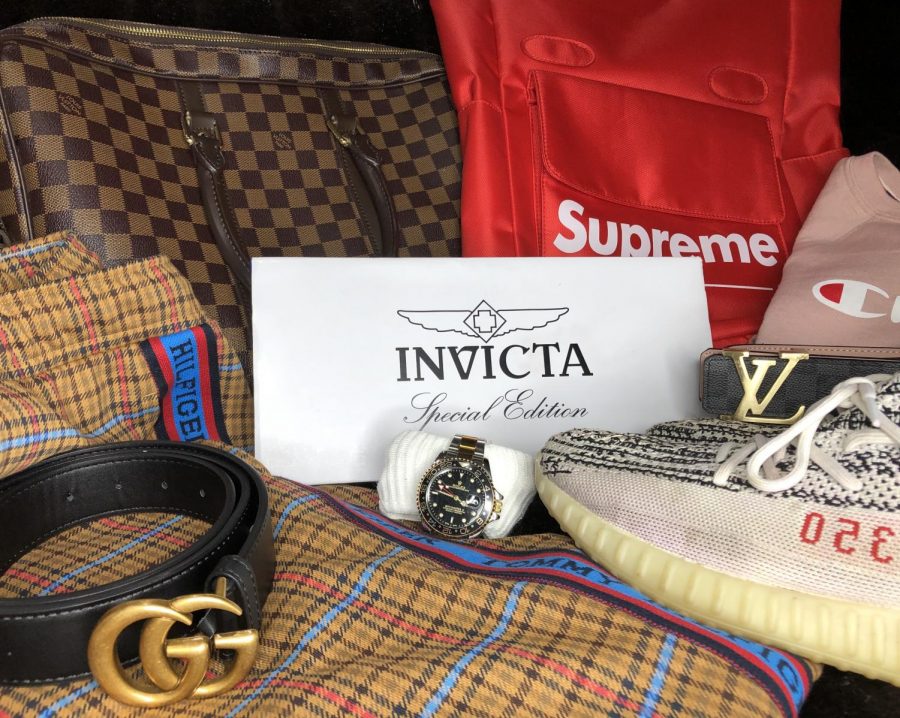Yuppies 2.0
The lifestyle of the 1980s’ young urban professional is undergoing a reboot with Millennials and Gen Z.
Millennial and Gen Z fashion and style are awash in luxury brands, such as Gucci, Tommy Hilfiger, Louis Vuitton, Invicta, Rolex, Supreme, Champion, and Yeezy.
Madonna knew the truth when she sang, “We are living in a material world.” It was especially true in the 1980s, when her hit single “Material Girl” was released. It was the decade of the “yuppie,” an acronym for young urban professional.
“Being a yuppie meant that you had a good-paying job right out of college and began to engage in the consumerism that so many associate with the 1980s,” NASH social studies teacher Jamey Pirring explained.
Forty years later, the term has not lost its relevance.
Although Pirring jokes that the average North Allegheny student would fit right in with 1980s’ yuppies, he actually may not be all that far off. We, in fact, are still living in a material world, and Millennials and Generation Z are making it their own.
“What’s happening here may be as significant as what happened during the late 1970s and into the 1980s, when young urban professionals became Yuppies, drove BMWs, and—in urban centers like New York—shopped at Ralph Lauren,” Greg Petro, a writer for Forbes, pointed out in an article last year.
“Now, as then,” Petro added, “young people are putting high value on status.”
History, we’re all taught, repeats itself.
“I don’t think much has changed in terms of why people find luxury items so appealing,” Pirring said. “In my opinion, society dictates so much of our behavior. The idea of keeping up with the Joneses is still alive and well.”
In fact, luxury fashion has been immensely profitable in the current era. According to Business Insider, Gucci’s sales in 2018 nearly doubled, with the demographic of consumers under 35 making up about 55 percent of the luxury company’s earnings. The magazine goes on to say that, in 2017, “18- to 35-year-olds contributed to an 85% growth in the luxury market.”
An Ad Age article posits that luxury fashion brands “focus on engaging millennial and Gen Z audiences” in hopes of creating a “long-term customer base” and to “ensure their ongoing relevance.” Additionally, companies have arranged their marketing alliances accordingly: Louis Vuitton has partnered with Riot Games, Gucci has adopted rapper Gucci Mane into its campaign, and Prada has paired with National Geographic.
Partnerships with popular streetwear brands are also central to luxury’s new strategy to grow its base, as Ralph Lauren has recently linked with Palace, Fendi with Fila, and Louis Vuitton with Supreme.
The music industry appears to be in on the game, too, with a seemingly endless numbers of songs mentioning brands like Fendi, Louis Vuitton, Yves Saint Laurent, Yeezy, Burberry, Givenchy, and other top brands. Gucci, however, appears to be an industry favorite, with releases like “Gucci Gang” by Lil Pump, “Gucci Flip Flops” Bhad Bhabie, and “I’m Gucci,” by Migos immediately coming to mind.
Perhaps the central appeal of luxury brands to young adults is summed up in the slang term “flex culture,” which Urban Dictionary defines as “showing off your valuables in a non-humble way.”
It’s actually not a new idea. In his 1899 book The Theory of the Leisure Class, Thorstein Veblen coined the term “conspicuous consumption” to describe the habit of purchasing non-essential, expensive merchandise to indicate status and wealth. The era was called The Gilded Age for good reason.
The recent phenomenon of “influencers” adds to today’s flex culture. A substantial number of celebrities whose fame originated on YouTube, TikTok, Instagram, and other social media platforms frequently flaunt luxury brands.
Not to be outdone by their social media counterparts, traditional celebrities embrace luxury with equal ardor, a prime example of which was Kylie Jenner ‘s photo with her daughter, Stormi Webster, in a Gucci baby carrier that cost over $800.
Here in North Allegheny, the ripple effects of a culture that flaunts status have certainly not gone unnoticed.
Bryn Hornyak, a junior who owns brands like Dior, Hermès, Prada, Versace, and Balenciaga, said, “Honestly, I don’t care when people say I flex on them. I mean, if I have a Gucci shirt, I’m going to wear it. I don’t go out often, so school is my big place to shine.”
Olivia Schenk takes a similarly assured approach.
“To me, ‘flexing’ is a really loose term because it can mean different things to different people depending on their income levels and beliefs,” said Schenk, who owns Chanel, Yeezy, Gucci, and Tiffany and Co. products. “I feel very lucky that I have the opportunity to own and wear these brands.”
However, Tristan Puschaver, who owns multiple MCM items, has a different point of view.
“It kind of feels awkward when I wear my Louis Vuitton chain or MCM items,” Puschaver said. “It feels like people are constantly looking at and judging you.”
Still, Puschaver, can’t help but admit that luxury branded items “just look so cool.”
Perhaps the economic fallout of the coronavirus quarantine will dampen luxury’s profits in the short-term, but as long as the urge to flex remains with us, it would be foolish to question luxury’s long-term prospects.

Jordan Atkins is a senior at NASH. She shows her Tiger pride every year on the school's varsity swimming and diving team. When not in the water, you can find Jordan teaching at Gymkhana Gymnastics or helping lead her church's elementary and middle school level youth programs. Politics are her thing, and she is very passionate about them. One day she will travel the world, but until then, you can catch...


